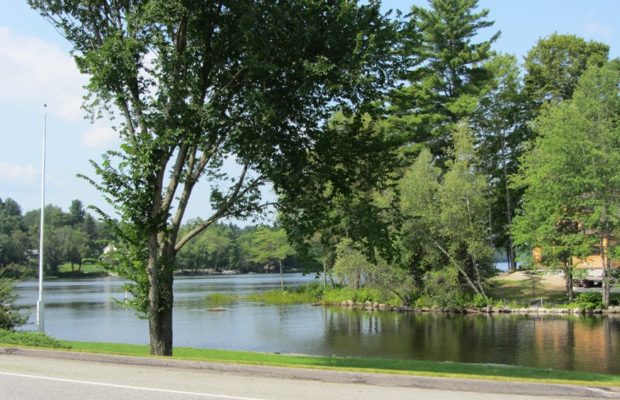
| Year | Population |
|---|---|
| 1970 | 577 |
| 1980 | 680 |
| 1990 | 1,029 |
| 2000 | 1,112 |
| 2010 | 1,189 |
| Geographic Data | |
|---|---|
| N. Latitude | 44:30:48 |
| W. Longitude | 69:26:08 |
| Maine House | District 76 |
| Maine Senate | District 22 |
| Congress | District 2 |
| Area sq. mi. | (total) 39.5 |
| Area sq. mi. | (land) 38.9 |
| Population/sq.mi. | (land) 52.5 |
| County: Kennebec
Total=land+water; Land=land only |
|
[WAYN] is a town in Kennebec County, incorporated on February 12, 1798 from New Sandwich Plantation. It annexed land from Leeds (1810, 1859), and from Livermore (1821), but conceded land to Winthrop (1816, 1838, 1852) and Readfield (1821). The first settler arrived from Sandwich, Massachusetts in 1773. It had also been known as Pocasset.
The town was named for General “Mad Anthony” Wayne, a Revolutionary War hero who commanded Fort Ticonderoga and Captured Stony Point, on the Hudson River, from the British.
Wayne is the birthplace of 19th century opera star Annie Louise Cary (1842-1921).
The late 19th century landscape was reported as follows in the Gazetteer of Maine:
At North Wayne, on the stream connecting Lovejoy’s with Wing’s Pond, are the mills of the North Wayne Paper Company; which, with the dwelling-houses and other buildings belonging to the company, constitute a pleasant little village. At Wayne village, on the stream connecting Wayne and Androscoggin ponds, are a woolen factory, a grist-mill, a shovel handle factory, and a sash and blind factory. Other manufactures at this place are carriages and tinware, machinery and harrows, and marble and granite works.
In its 2001 Comprehensive Plan, the town was characterized as “composed primarily of residences, small farms, seasonal and vacation homes, and limited retail and commercial development.”
The main village lies between Pocasset Lake and Androscoggin Lake on Maine Route 133. Other substantial ponds add to the town’s recreational attractions, even in winter when ice fishing is in full swing.
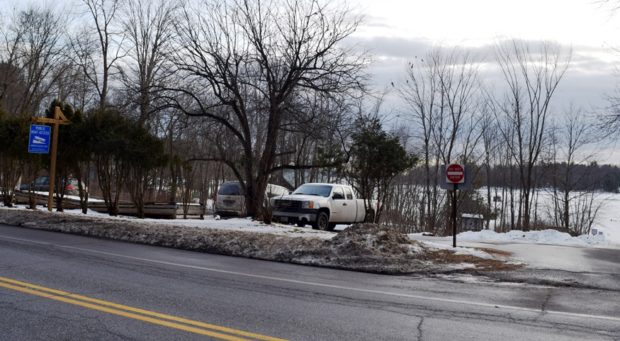
Boat launch area on Androscoggin Lake off Route 133 in Wayne. Ice fishing on the frozen lake. (2020)
Form of Government: Town Meeting-Select Board-Manager.
Additional resources
History of the Town of Wayne, Kennebec County, Maine: From its Settlement to 1898. Winthrop, Me. Wilson Pond Press. 1970.
History of Wayne, Maine. 1998. (“In celebration of Wayne’s Bicentennial 1798-1998.”)
Kallop, Edward L. Golden Summertime: A Portrait of Vacation Life in Wayne, Maine, 1890-1960. Wayne, Me. Wayne Historical Society. 2005. [University of Maine, Raymond H. Fogler Library, Special Collections; Maine State Library]
Kallop, Edward L. A History of the North Wayne Tool Co.: Manufacturers of Axes, Corn Hooks, Scythes and Hay Knives. Wayne, Me. Wayne Historical Society. 2003. [University of Maine, Raymond H. Fogler Library, Special Collections; Maine State Library]
Kallop, Edward L. Johnson’s Kingdom: The Story of a Nineteenth-Century Industrial Kingdom in the Town of Wayne, Maine. Wayne, Me. Wayne Historical Society. 2000.
Mitchell, H. E. (Harry Edward). The Town Register: Wayne, Wales, Monmouth, Leeds, Greene, 1905. Brunswick, Me. H. E. Mitchell. 1905.
Perkins, Jack. Illustrated History of Wayne, Maine; being a contemporary and past history of a small New England Town. Wayne, Me. 1968.
Town of Wayne Comprehensive Plan 2001. (available through the Town’s web site: http://www.waynemaine.org (accessed April 27, 2012)
*United States. Department of the Interior. National Park service. “Wayne Town House.” https://npgallery.nps.gov/pdfhost/docs/nrhp/text/76000098.PDF (accessed March 11, 2017)
Varney, George J. A Gazetteer of the State of Maine. 1886. pp. 573-574.
National Register of Historic Places – Listings
Androscoggin Yacht Club
[22 Lake Street.]
“There are many persons who have watched with interest the steady increase in summer activities on and about Androscoggin and Pocasset Lakes, and who are of the opinion that it would of great advantage to all concerned to afford these activities adequate protection and encouragement.”
Believing that a yacht club would be of assistance in accomplishing these ends, as well as enhancing the attractiveness of Wayne as a summer resort, a small meeting was arranged for Thursday, August 5, 1909, at 3 p.m. to discuss the organization of such a yacht club.” From the organizational meeting to discuss the formation of the Androscoggin Yacht Club. Soon thereafter the group adopted a list of purposes for the club: “promotion of the yachting and boating on the waters of Lakes Androscoggin and Pocasset, protection and preservation of the fishes and game on the waters thereof and care and improvement of the shores of said lakes.” The above is from the Yacht Club’s web site at http://aycwayne.org/history-of-the-androscoggin-yacht-club/ (accessed June 20, 2018)
The Androscoggin Yacht Club on Androscoggin Lake in Wayne, is among the oldest surviving yacht club organizations in Maine, and perhaps the oldest such facility located on an inland waterway, still being used for its original function. First incorporated in 1909, the organization purchased land and opened its clubhouse and docks in 1912. The wood frame clubhouse with wraparound porch and generous meeting hall was designed by architect Carl Fuller Davis of Bridgeport, Connecticut. The Androscoggin Yacht Club is significant as a remarkably well-persevered social building that was built as clubhouses for fishing lodges, golf clubs, yacht clubs and social organizations, mostly in tourist-oriented towns or private communities, in the early decades of the 20th century. It is also a building that reflects the development of forms of entertainment and recreation in Wayne, a small town with a substantial summer population.
Wayne Town House
[Maine Route 133] The 1840 town house in Wayne is among the earliest in Maine. The interior is comprised of an open meeting room. A large floor space in the center is flanked on the east and west walls by original plank benches placed in a graduated elevation from the floor like modern bleachers.
It is the only one remaining in the state where not only are the benches for men and women (who originally could not vote) on opposite sides facing each other on a sloping floor, but where the segregation of sexes at town meeting time was, in 1975, still observed for tradition’s sake.
For 42 years prior to the erection of this building, annual and other business meetings of the town were held in private buildings, school houses or the Methodist Church. In 1839 the inhabitants of the town voted to build a town house and in 1840 specified that the foundations should be made three feet thick.* [See photo above.]
Wing Family Cemetery
 [Pond Road, east side, north of junction with Maine Route 133] This treasured burial ground was laid out in 1867, to be built in circular configurations. At the precise center of the grounds stands a 12-foot-high granite obelisk, which is the focal point of an elevated circular mound 14 feet in diameter, which in turn is surrounded by a three-foot-deep dry moat.
[Pond Road, east side, north of junction with Maine Route 133] This treasured burial ground was laid out in 1867, to be built in circular configurations. At the precise center of the grounds stands a 12-foot-high granite obelisk, which is the focal point of an elevated circular mound 14 feet in diameter, which in turn is surrounded by a three-foot-deep dry moat.
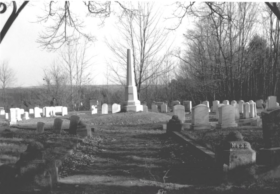 On the monument’s octagonal base, facing the gate and entrance walk, is inscribed the name “WING” and the date 1871. On each of the other seven sides, facing the lots, is inscribed the name of one of the original seven brothers, all of whom came to Wayne in the 1780s. Proceeding in the circle, to the right, going counter clockwise around the monument they are: Simeon Jr., Alien, Ebenezer, Aaron, Moses, Thomas, and William.
On the monument’s octagonal base, facing the gate and entrance walk, is inscribed the name “WING” and the date 1871. On each of the other seven sides, facing the lots, is inscribed the name of one of the original seven brothers, all of whom came to Wayne in the 1780s. Proceeding in the circle, to the right, going counter clockwise around the monument they are: Simeon Jr., Alien, Ebenezer, Aaron, Moses, Thomas, and William.
Circling this impressive center are concentric rings, each ring separated by graveled walks and curbed with cut granite which serves as a base for the headstones, thus assuring they are arranged in a perfect circle. Intended to provide a family genealogy, each ring includes the graves of members of succeeding generations descended from whichever of the seven brothers the headstones face.
Entering the yard through its handsome wrought iron gate one cannot help but be impressed by the neat and orderly placement of the headstones. On reading the inscriptions on some of the stones it becomes apparent that dates of death in many cases occurred years before the present cemetery came into being.* [Kirk F. Mohney photos, 1990]


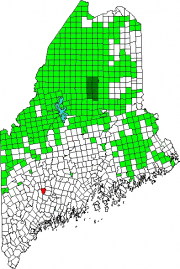
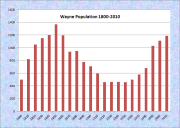
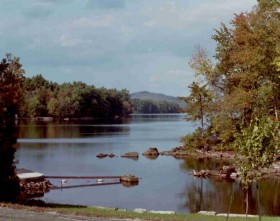
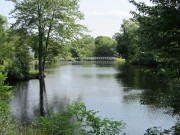

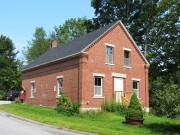
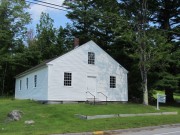
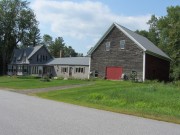

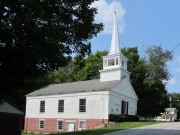
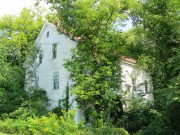

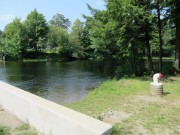
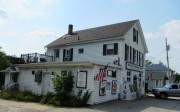
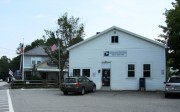
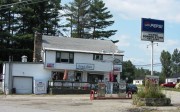
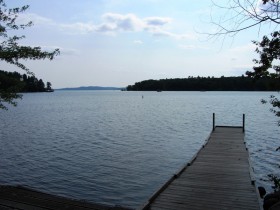

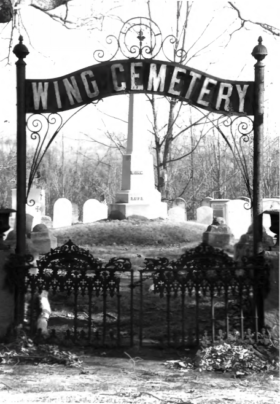
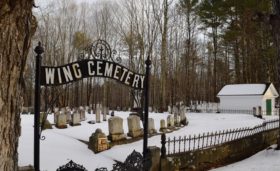
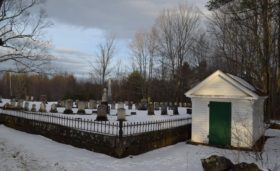
I was trying to find out who the men were that started building guns or rifles actuallly in an old house in Wayne. I know that the couple that owned it until their deaths were from Wayne with the man being a judge. I’m trying to find out who the gun manufacturer in that house was by name. It was the 1800’s. I painted this house for Margaret and the Judge many years ago and she told me this story about their house being a gun shop.